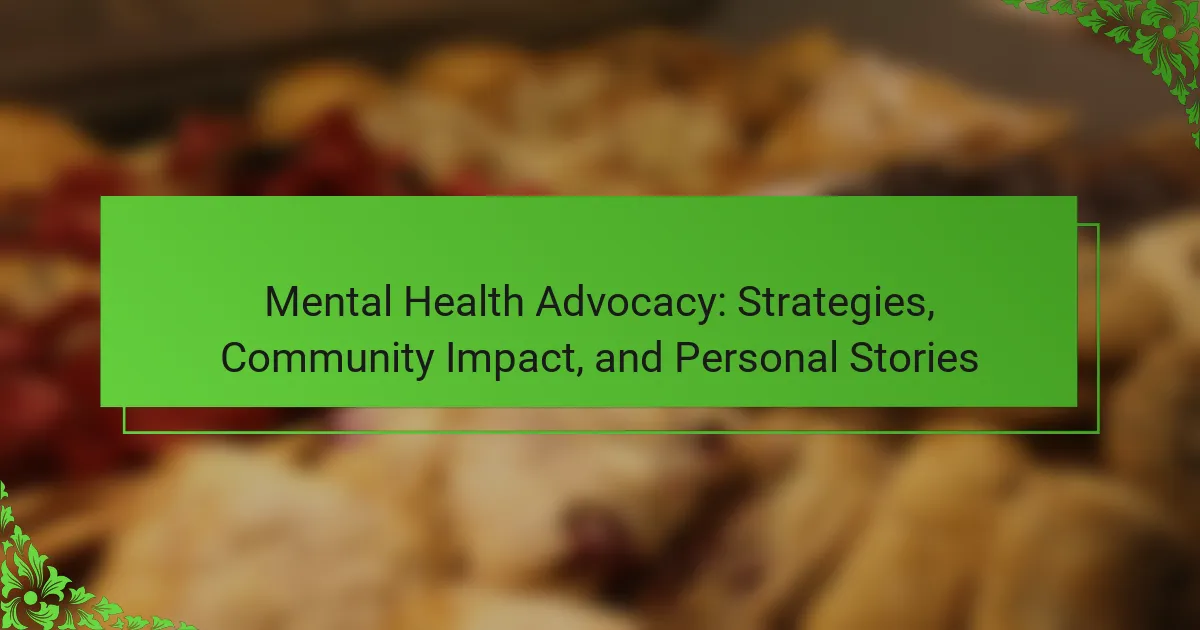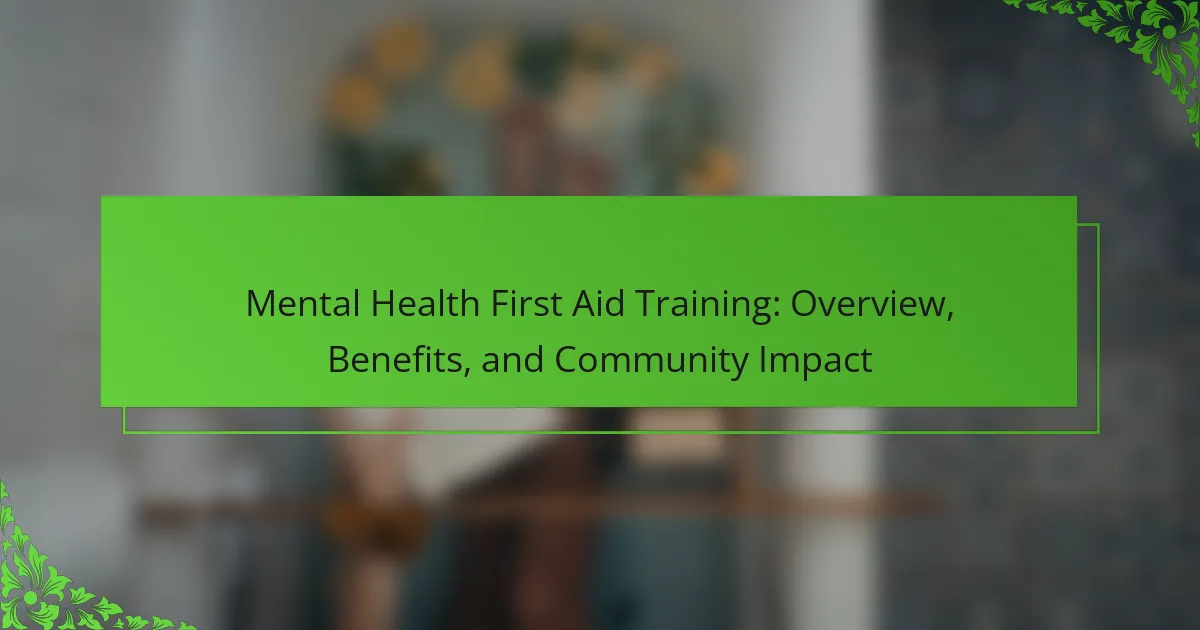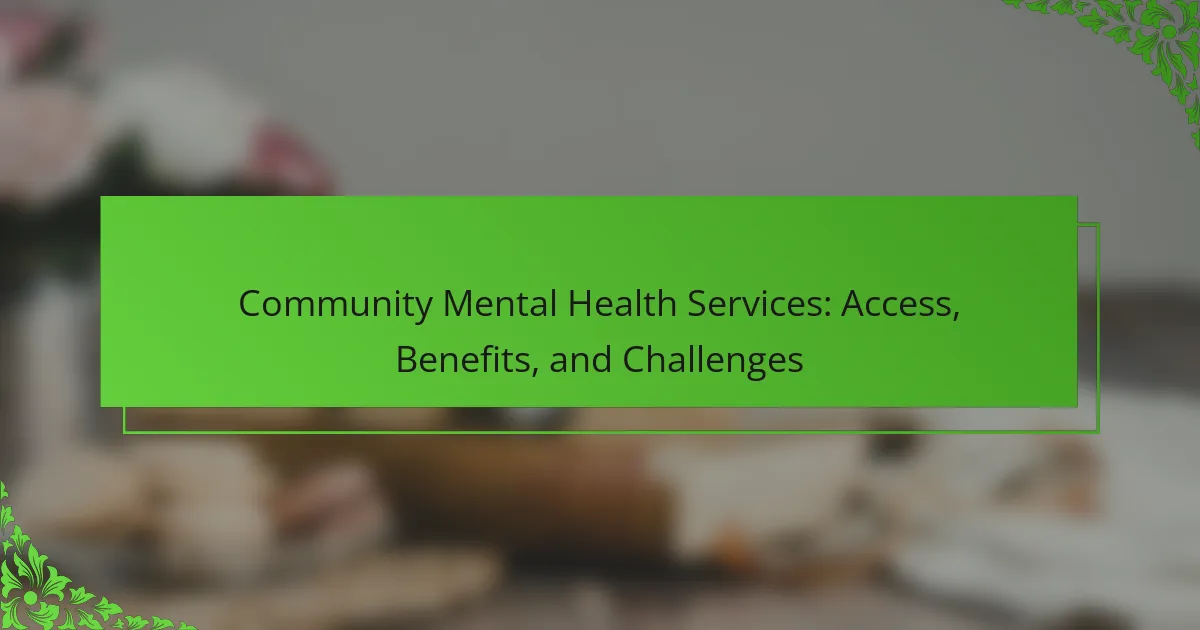Mental health advocacy plays a crucial role in enhancing community well-being and reducing stigma. This article explores effective strategies for raising awareness, the impact of personal stories, and the importance of engaging with policymakers. It also highlights common pitfalls in advocacy efforts and metrics to evaluate success. By fostering understanding and support, mental health advocacy empowers individuals and builds resilient communities.
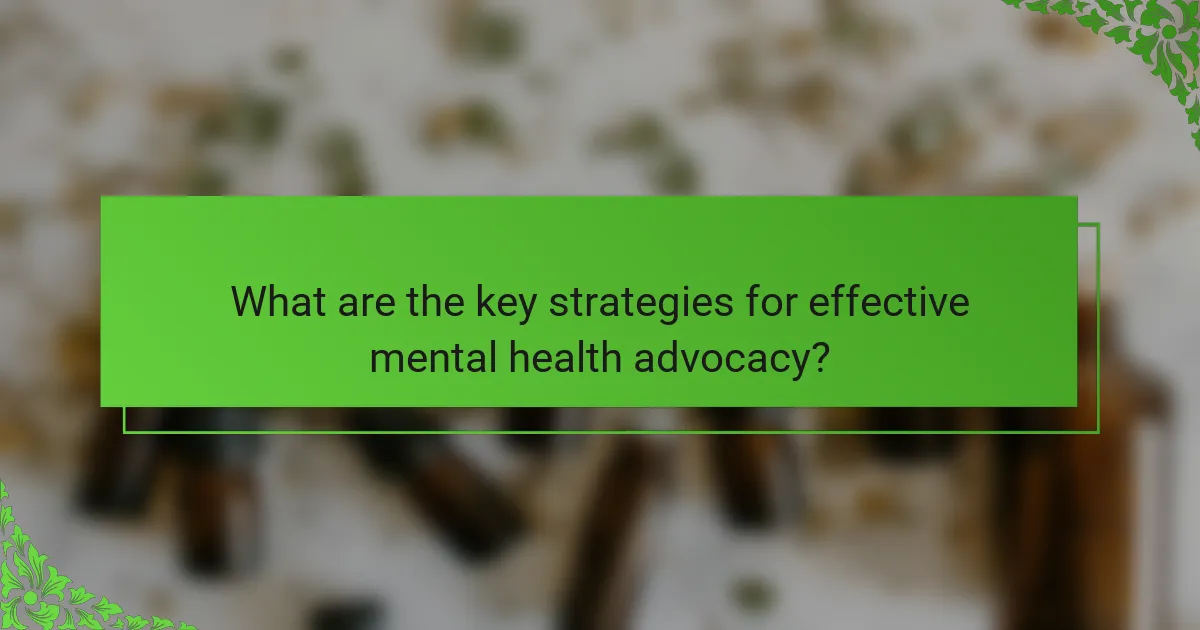
What are the key strategies for effective mental health advocacy?
Effective mental health advocacy involves raising awareness, building community support, and sharing personal experiences. Key strategies include educating the public about mental health issues, fostering partnerships with local organizations, and using social media to amplify voices. Engaging with policymakers to influence mental health legislation is crucial. Additionally, creating safe spaces for dialogue encourages individuals to share their stories, reducing stigma and promoting understanding.
How can community engagement enhance advocacy efforts?
Community engagement significantly enhances advocacy efforts by fostering connections, building trust, and amplifying voices. Engaged communities can mobilize resources and support, driving awareness and action around mental health issues. Collaborative initiatives often lead to shared ownership of advocacy goals, resulting in more effective campaigns. Personal stories from community members can resonate deeply, inspiring others and creating a more inclusive dialogue around mental health.
Which organizations lead the way in mental health advocacy?
Several organizations lead in mental health advocacy, including the National Alliance on Mental Illness (NAMI), Mental Health America (MHA), and the World Health Organization (WHO). These entities focus on raising awareness, providing resources, and influencing policy. NAMI emphasizes peer support and education, while MHA promotes prevention and early intervention. WHO works globally to improve mental health standards and access to care. Their collaborative efforts significantly impact community mental health initiatives and personal recovery stories.
What role does education play in mental health awareness?
Education plays a crucial role in mental health awareness by equipping individuals with knowledge and skills. It fosters understanding of mental health issues, reduces stigma, and promotes early intervention. Programs in schools and communities raise awareness and encourage open discussions about mental health. Research shows that educated individuals are more likely to seek help and support others facing mental health challenges.
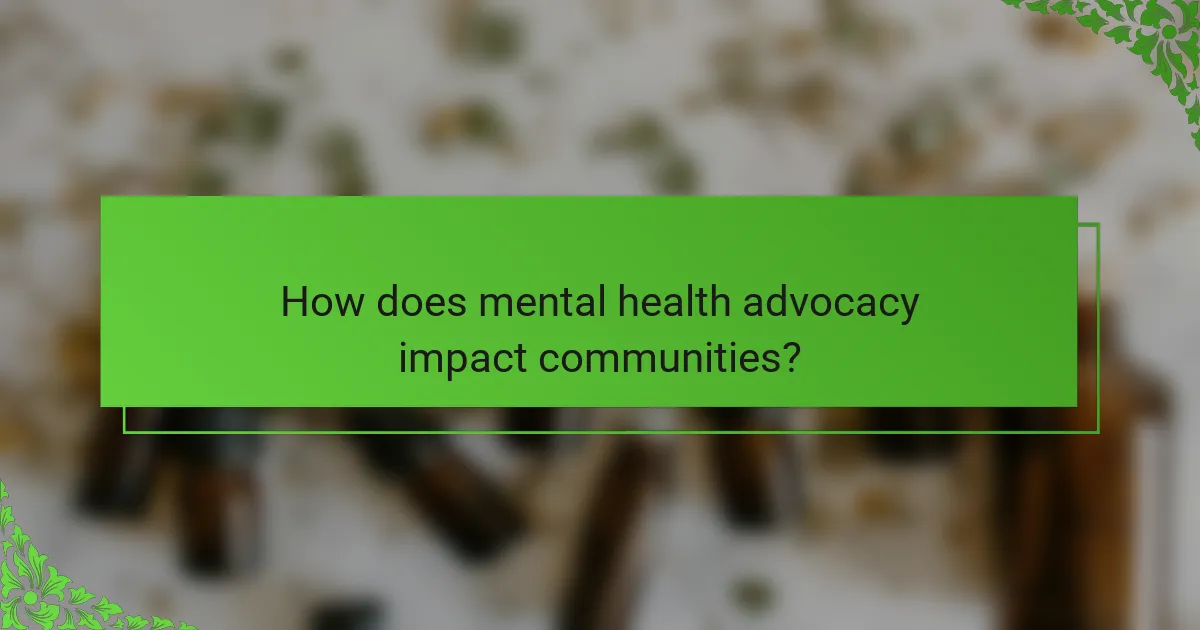
How does mental health advocacy impact communities?
Mental health advocacy significantly enhances community well-being by fostering awareness, reducing stigma, and promoting access to resources. It empowers individuals to seek help and encourages collective support. Effective advocacy leads to improved mental health services, increased funding, and community programs that address mental health needs. Personal stories shared during advocacy efforts often resonate deeply, encouraging others to engage and seek support. As a result, communities become more resilient and supportive environments for mental health.
What are the measurable benefits of advocacy on public health?
Mental health advocacy significantly enhances public health by promoting awareness, reducing stigma, and improving access to services. These benefits lead to increased community support and better individual outcomes. Advocacy initiatives can raise funding for mental health programs, resulting in improved resources and support systems. Furthermore, personal stories shared in advocacy can foster empathy and understanding, driving social change.
How can advocacy reduce stigma around mental health issues?
Advocacy can significantly reduce stigma around mental health issues by promoting awareness and understanding. It fosters open conversations, challenges misconceptions, and encourages individuals to seek help without fear of judgment. Community programs and personal stories of recovery play a crucial role in normalizing mental health discussions. As a result, increased visibility leads to greater acceptance and support for those affected.
What are the challenges faced by advocates in different regions?
Advocates face various challenges in mental health advocacy across different regions. These challenges include stigma, limited resources, and varying cultural perceptions of mental health. Additionally, legal and policy barriers can hinder effective advocacy efforts. In some regions, language differences complicate communication and outreach. Advocates also struggle with burnout, especially in areas with high demand for support services.
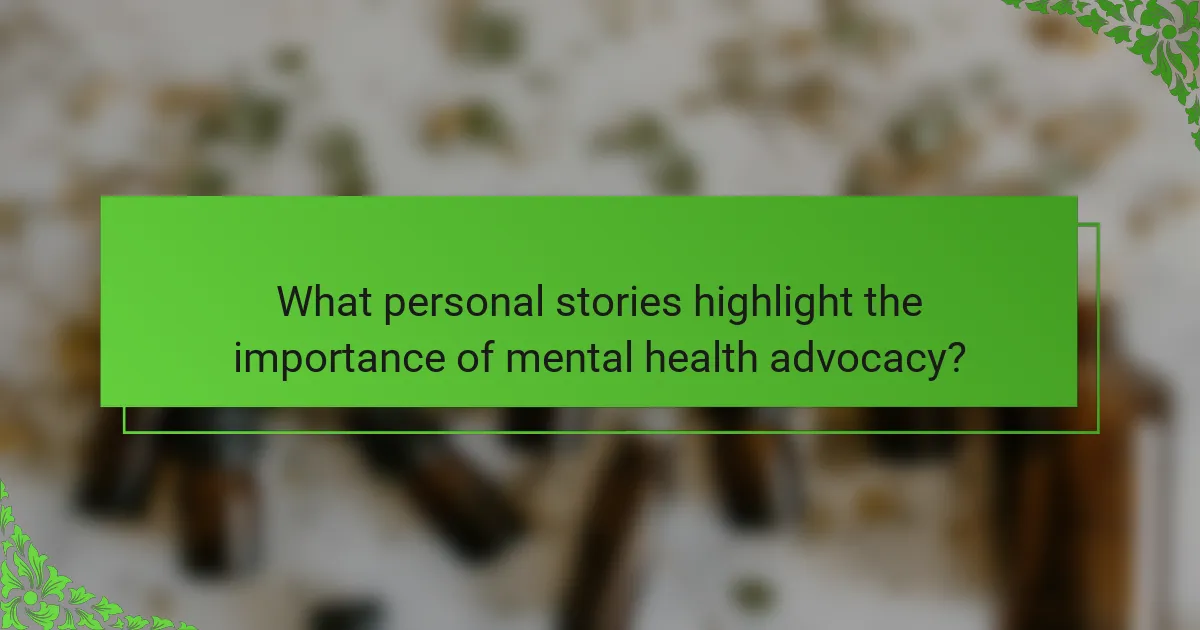
What personal stories highlight the importance of mental health advocacy?
Personal stories underscore the profound impact of mental health advocacy. They reveal how sharing experiences fosters understanding and reduces stigma. For instance, individuals recount overcoming personal struggles, inspiring others to seek help. These narratives often highlight community support, showcasing collective resilience. Advocacy efforts amplify these voices, promoting awareness and encouraging open conversations about mental health.
How do individual experiences shape advocacy narratives?
Individual experiences significantly shape advocacy narratives by providing authenticity and relatability. Personal stories resonate with audiences, fostering empathy and understanding. These narratives often highlight unique challenges and successes, illustrating the diverse aspects of mental health. They empower others to share their experiences, creating a collective voice that drives change and awareness.
What unique approaches have individuals taken to advocate for mental health?
Individuals have taken diverse approaches to advocate for mental health, focusing on personal stories and community engagement. Many use social media platforms to share their experiences, fostering connection and reducing stigma. Peer support groups provide safe spaces for open dialogue, empowering participants to share their journeys. Creative arts, such as writing and visual art, serve as powerful tools for expression and awareness. Additionally, some advocates engage in policy change efforts, collaborating with organizations to influence mental health legislation. These unique strategies collectively enhance community understanding and support for mental health issues.
Which stories have led to significant changes in policy or perception?
Personal stories in mental health advocacy have led to significant policy changes and shifts in public perception. For instance, the narrative of Kevin Hines, a suicide attempt survivor, has sparked discussions on mental health resources and prevention strategies. Similarly, the advocacy of celebrities like Lady Gaga has increased awareness and funding for mental health initiatives. These stories resonate deeply, prompting legislative actions and community programs aimed at improving mental health support.
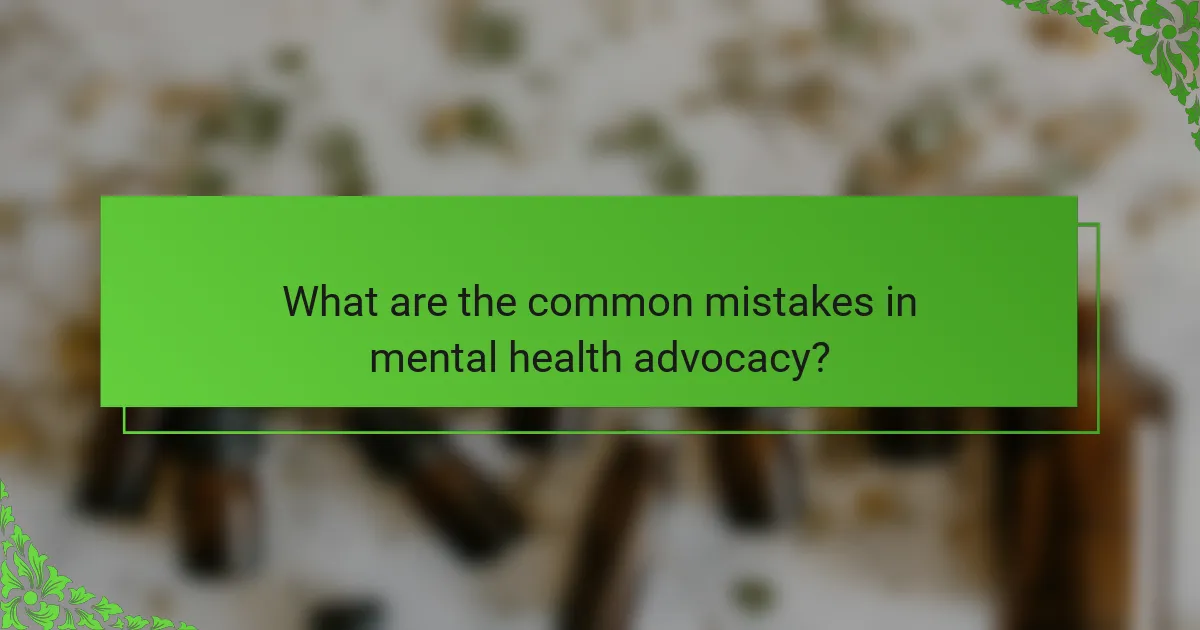
What are the common mistakes in mental health advocacy?
Common mistakes in mental health advocacy include oversimplifying complex issues, neglecting diverse perspectives, and failing to engage with affected communities. Advocates may also rely on stereotypes, overlook the importance of self-care, and miscommunicate the urgency of mental health needs. These errors can undermine the effectiveness of advocacy efforts and alienate potential supporters.
How can advocates avoid burnout while pursuing their goals?
Advocates can avoid burnout by setting boundaries, practicing self-care, and seeking support. Prioritizing mental health is crucial for sustained advocacy efforts. Establishing a balanced routine helps manage stress and maintain motivation. Engaging with a supportive community fosters resilience and shared experiences.
What are the best practices for effective communication in advocacy?
Effective communication in advocacy requires clarity, empathy, and active listening. Building relationships with stakeholders enhances trust and engagement.
1. Establish clear goals for your advocacy message.
2. Use relatable stories to illustrate your points.
3. Adapt your communication style to your audience’s needs.
4. Foster open dialogue to encourage feedback and collaboration.
5. Utilize multiple platforms to reach a broader audience.
6. Follow up to maintain relationships and assess impact.
How can advocates build a sustainable support network?
Advocates can build a sustainable support network by fostering relationships, sharing resources, and promoting mental health awareness. Engaging with local organizations enhances community ties and provides valuable support. Regular events, workshops, and online platforms can facilitate ongoing communication and collaboration. Personal stories can inspire others and create a sense of belonging, strengthening the network’s impact.

Which metrics can be used to evaluate the success of advocacy initiatives?
Metrics to evaluate the success of advocacy initiatives include engagement levels, awareness increase, policy changes, community feedback, and funding growth. These metrics provide insight into the effectiveness of mental health advocacy efforts.
| Metric | Description | Value Example |
|———————–|——————————————————|————————-|
| Engagement Levels | Measure of participation in advocacy activities | Number of event attendees|
| Awareness Increase | Change in public knowledge about mental health issues | Survey results on awareness|
| Policy Changes | Number of new policies influenced by advocacy efforts | Legislative changes |
| Community Feedback | Responses from the community regarding initiatives | Feedback survey ratings |
| Funding Growth | Increase in financial support for advocacy programs | Percentage increase in donations|
What role does social media play in measuring advocacy impact?
Social media significantly measures advocacy impact by tracking engagement metrics and community feedback. Platforms provide real-time data on reach, shares, and comments, reflecting public sentiment. These insights help organizations adjust strategies for better outreach. For example, a campaign gaining high shares indicates effective messaging. Additionally, personal stories shared online foster community support and connection, amplifying advocacy efforts.
How can feedback from the community improve advocacy efforts?
Feedback from the community enhances mental health advocacy by fostering collaboration and tailoring efforts to specific needs. Engaging community members allows advocates to gather diverse perspectives and identify pressing issues. This feedback can lead to more effective campaigns, as advocates can adjust strategies based on community insights. Additionally, personal stories shared by individuals can humanize mental health challenges, creating a stronger emotional connection and driving engagement. Ultimately, community feedback empowers advocates to create targeted initiatives that resonate with their audience, leading to improved outcomes in mental health awareness and support.
What are the key indicators of progress in mental health advocacy?
Key indicators of progress in mental health advocacy include increased awareness, improved access to services, and enhanced policy support. These metrics demonstrate the effectiveness of advocacy efforts in reducing stigma and promoting mental health resources. For example, a rise in public discussions about mental health reflects greater societal acceptance. Additionally, data shows that more individuals are seeking mental health services, indicating improved access. Finally, legislative changes that support mental health initiatives highlight successful advocacy at the policy level.
What expert tips can enhance the effectiveness of mental health advocacy?
To enhance the effectiveness of mental health advocacy, focus on building community connections and sharing personal stories. Engaging with local organizations fosters collaboration and amplifies voices. Utilize social media platforms to reach wider audiences and create awareness. Data-driven campaigns can highlight the urgency of mental health issues, making advocacy efforts more compelling. Lastly, training advocates in effective communication skills ensures messages resonate and inspire action.
